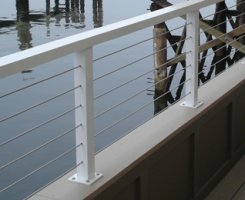tbz
Silver Member
Good afternoon everyone,
Please comment on the following situation, I am not sure of all the facts, but enough to be able to layout the question for comments.
1. Fabricator built a guard for a commercial client to sit on top of a solid wall 24" High (example pic below is not the site but only for reference)


2. Posts set with 38" between verticals
3. Cables set with maximum of 3" between cables
4. (I am not sure about how much tension is on the cables) But I am told that it takes a strong shove with 2 hands and some weight behind him for the inspector to push/force a 4" sphere through between 2 cables mid span (center would be 19").
I personally have done many guards with cable infill like this over the past 27 years and never had an inspector fail for forcefully pushing the 4" sphere through.
Again I point out, not my project.
The fabricator is telling me that the inspector is not correct because the inspector will not give the fabricator a section other than 1013's 4 sphere rule and the fabricator says that 1013 tells you to look to 1607.7 for loads and the force on infill is 50 lbs/per sq/ft.
I am told that a 50 lb force on the 4" sphere will not pass between the cables, Have not seen this with my own eyes, just told.
Here in lies my question to all?
When inspecting for infill spread, if you do, I would venture that you all treat all types of infill the same (IE: wood balusters, metal balusters, plastic, cable, concrete, Fypon and so on, at what point to you treat pass and fail for the 4" sphere?
I have always been told treat the guard like one of those games with the little steel balls and the maze with the holes in it, if you are rolling the sphere over the guard and it falls through it fails, no load.
I have had many conversations with inspectors on 4" sphere force or no force, but still an open opinion.
Please comment
Please comment on the following situation, I am not sure of all the facts, but enough to be able to layout the question for comments.
1. Fabricator built a guard for a commercial client to sit on top of a solid wall 24" High (example pic below is not the site but only for reference)


2. Posts set with 38" between verticals
3. Cables set with maximum of 3" between cables
4. (I am not sure about how much tension is on the cables) But I am told that it takes a strong shove with 2 hands and some weight behind him for the inspector to push/force a 4" sphere through between 2 cables mid span (center would be 19").
I personally have done many guards with cable infill like this over the past 27 years and never had an inspector fail for forcefully pushing the 4" sphere through.
Again I point out, not my project.
The fabricator is telling me that the inspector is not correct because the inspector will not give the fabricator a section other than 1013's 4 sphere rule and the fabricator says that 1013 tells you to look to 1607.7 for loads and the force on infill is 50 lbs/per sq/ft.
I am told that a 50 lb force on the 4" sphere will not pass between the cables, Have not seen this with my own eyes, just told.
Here in lies my question to all?
When inspecting for infill spread, if you do, I would venture that you all treat all types of infill the same (IE: wood balusters, metal balusters, plastic, cable, concrete, Fypon and so on, at what point to you treat pass and fail for the 4" sphere?
I have always been told treat the guard like one of those games with the little steel balls and the maze with the holes in it, if you are rolling the sphere over the guard and it falls through it fails, no load.
I have had many conversations with inspectors on 4" sphere force or no force, but still an open opinion.
Please comment
Last edited by a moderator:
